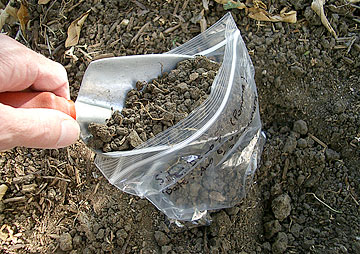- Home
- Learn about salinity
- Get to know your site
- Design a landscape
- Solve a problem
- Other information
Salinity Management Guide

Assessing the chemistry of soil
Measuring the salinity-related chemical parameters for a landscape's soil can help reveal the presence and magnitude of existing or potential problems involving salinity.
Ascertain the following by sampling the landscape's soil and submitting the samples to a laboratory.
- Electrical conductivity of the soil, expressed in dS/m
This parameter, denoted ECe, is determined by measuring the electrical conductivity of water extracted from a water-saturated paste made from a sample of the soil. (The "e" in the abbreviation ECe stands for "extract.") Greater electrical conductivity indicates greater salinity. Excessive amounts of salt can injure salt-sensitive plants.
- Concentrations of particular ions in the soil, expressed in mg/l
Ions most often of interest are sodium ion (Na+), chloride ion (Cl-), and ammonium ion (NH4+). Excesses of these can harm some plants.
- Sodium absorption ratio, SAR, or exchangeable sodium percentage, ESP
These ratios are calculated based on the concentrations of sodium ion (Na+), calcium ion (Ca2+), and magnesium ion (Mg2+). They help indicate whether the soil is apt to become less permeable.
- Concentration of boron (B) in the soil, expressed in mg/l or ppm
An excess of boron has a deleterious affect on plants.
- pH of the soil, unitless
The acidity or alkalinity of a soil, as indicated by the soil's pH, affects the solubility of ions and the activity of micro-organisms, both of which indirectly affect the growth of plants.
| « Previous page | Next page » |